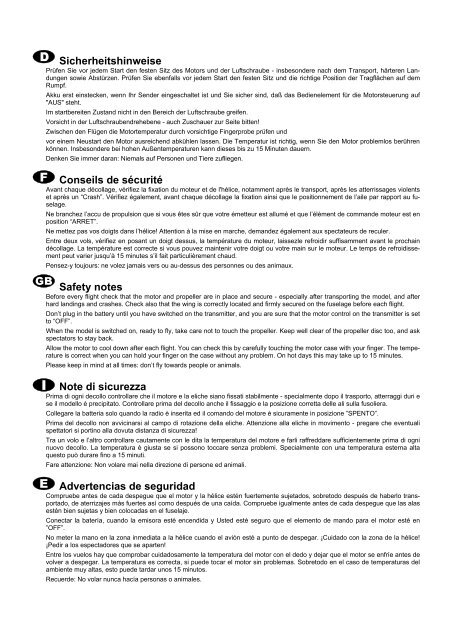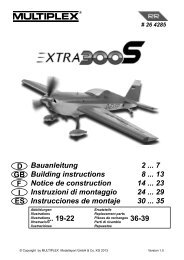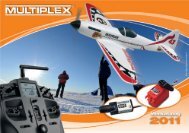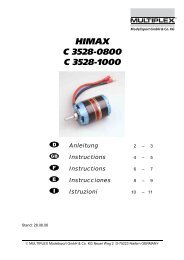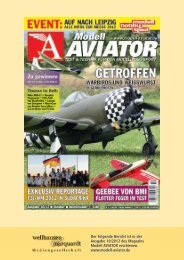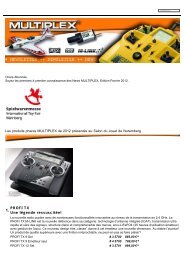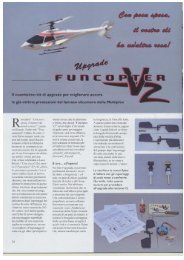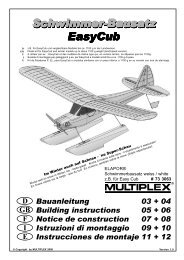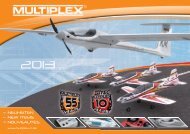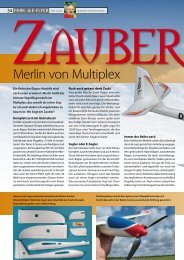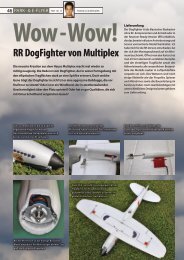Bauanleitung 03 ... 11 Building instructions 12 ... 20 ... - Multiplex
Bauanleitung 03 ... 11 Building instructions 12 ... 20 ... - Multiplex
Bauanleitung 03 ... 11 Building instructions 12 ... 20 ... - Multiplex
You also want an ePaper? Increase the reach of your titles
YUMPU automatically turns print PDFs into web optimized ePapers that Google loves.
Sicherheitshinweise<br />
Prüfen Sie vor jedem Start den festen Sitz des Motors und der Luftschraube - insbesondere nach dem Transport, härteren Landungen<br />
sowie Abstürzen. Prüfen Sie ebenfalls vor jedem Start den festen Sitz und die richtige Position der Tragflächen auf dem<br />
Rumpf.<br />
Akku erst einstecken, wenn Ihr Sender eingeschaltet ist und Sie sicher sind, daß das Bedienelement für die Motorsteuerung auf<br />
"AUS" steht.<br />
Im startbereiten Zustand nicht in den Bereich der Luftschraube greifen.<br />
Vorsicht in der Luftschraubendrehebene - auch Zuschauer zur Seite bitten!<br />
Zwischen den Flügen die Motortemperatur durch vorsichtige Fingerprobe prüfen und<br />
vor einem Neustart den Motor ausreichend abkühlen lassen. Die Temperatur ist richtig, wenn Sie den Motor problemlos berühren<br />
können. Insbesondere bei hohen Außentemperaturen kann dieses bis zu 15 Minuten dauern.<br />
Denken Sie immer daran: Niemals auf Personen und Tiere zufliegen.<br />
Conseils de sécurité<br />
Avant chaque décollage, vérifiez la fixation du moteur et de l'hélice, notamment après le transport, après les atterrissages violents<br />
et après un “Crash”. Vérifiez également, avant chaque décollage la fixation ainsi que le positionnement de l’aile par rapport au fuselage.<br />
Ne branchez l’accu de propulsion que si vous êtes sûr que votre émetteur est allumé et que l’élément de commande moteur est en<br />
position “ARRET”.<br />
Ne mettez pas vos doigts dans l’hélice! Attention à la mise en marche, demandez également aux spectateurs de reculer.<br />
Entre deux vols, vérifiez en posant un doigt dessus, la température du moteur, laissezle refroidir suffisamment avant le prochain<br />
décollage. La température est correcte si vous pouvez maintenir votre doigt ou votre main sur le moteur. Le temps de refroidissement<br />
peut varier jusqu’à 15 minutes s’il fait particulièrement chaud.<br />
Pensez-y toujours: ne volez jamais vers ou au-dessus des personnes ou des animaux.<br />
Safety notes<br />
Before every flight check that the motor and propeller are in place and secure - especially after transporting the model, and after<br />
hard landings and crashes. Check also that the wing is correctly located and firmly secured on the fuselage before each flight.<br />
Don’t plug in the battery until you have switched on the transmitter, and you are sure that the motor control on the transmitter is set<br />
to “OFF”.<br />
When the model is switched on, ready to fly, take care not to touch the propeller. Keep well clear of the propeller disc too, and ask<br />
spectators to stay back.<br />
Allow the motor to cool down after each flight. You can check this by carefully touching the motor case with your finger. The temperature<br />
is correct when you can hold your finger on the case without any problem. On hot days this may take up to 15 minutes.<br />
Please keep in mind at all times: don’t fly towards people or animals.<br />
Note di sicurezza<br />
Prima di ogni decollo controllare che il motore e la eliche siano fissati stabilmente - specialmente dopo il trasporto, atterraggi duri e<br />
se il modello è precipitato. Controllare prima del decollo anche il fissaggio e la posizione corretta delle ali sulla fusoliera.<br />
Collegare la batteria solo quando la radio è inserita ed il comando del motore è sicuramente in posizione ”SPENTO”.<br />
Prima del decollo non avvicinarsi al campo di rotazione della eliche. Attenzione alla eliche in movimento - pregare che eventuali<br />
spettatori si portino alla dovuta distanza di sicurezza!<br />
Tra un volo e l’altro controllare cautamente con le dita la temperatura del motore e farli raffreddare sufficientemente prima di ogni<br />
nuovo decollo. La temperatura è giusta se si possono toccare senza problemi. Specialmente con una temperatura esterna alta<br />
questo può durare fino a 15 minuti.<br />
Fare attenzione: Non volare mai nella direzione di persone ed animali.<br />
Advertencias de seguridad<br />
Compruebe antes de cada despegue que el motor y la hélice estén fuertemente sujetados, sobretodo después de haberlo transportado,<br />
de aterrizajes más fuertes así como después de una caída. Compruebe igualmente antes de cada despegue que las alas<br />
estén bien sujetas y bien colocadas en el fuselaje.<br />
Conectar la batería, cuando la emisora esté encendida y Usted esté seguro que el elemento de mando para el motor esté en<br />
”OFF”.<br />
No meter la mano en la zona inmediata a la hélice cuando el avión esté a punto de despegar. ¡Cuidado con la zona de la hélice!<br />
¡Pedir a los espectadores que se aparten!<br />
Entre los vuelos hay que comprobar cuidadosamente la temperatura del motor con el dedo y dejar que el motor se enfríe antes de<br />
volver a despegar. La temperatura es correcta, si puede tocar el motor sin problemas. Sobretodo en el caso de temperaturas del<br />
ambiente muy altas, esto puede tardar unos 15 minutos.<br />
Recuerde: No volar nunca hacía personas o animales.


